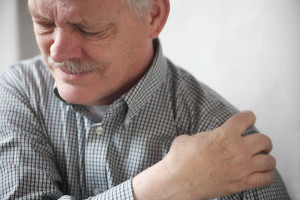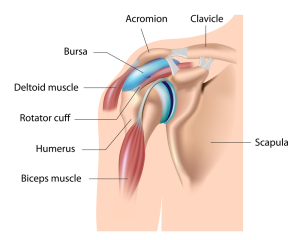Introduction
Comparatively, the shoulder joint is the most vulnerable joint in the body as it is very prominent and very mobile. For this reason it is, therefore, no surprise that the shoulder is prone to developing shoulder pain.
In like manner there are limitations with regard to the bony support and this consists of the acromion process of the shoulder blade and the clavicle with the acromioclavicular joint. In addition, there are also some supportive ligaments and several bursae. These are hollow pockets with slime in it that help to allow different tissue levels to move around easily .
In general, there are also the supportive shoulder girdle muscles and the muscles and tendons that are part of the rotator cuff mechanism. All in all, with all of these support mechanisms for the shoulder joint it becomes possible to forward flex 180° and abduct 180°as well.
Specifically, the first 90°of this range of motion takes place in the acromiohumeral joint (the articulation between the acromion and the humeral head). Then, the 90°to 180°motion takes place in the “sub scapular joint”. This is the summation of tissues underneath the shoulder blade, in the space between the chest wall and the shoulder blade. Notably, this very soft connective tissue in cooperation with the subscapular bursa enables us to reach up high, to throw and pitch baseballs, to play tennis, golf and swim with a breaststroke. Normally we have no pain. But when the shoulder is painful, then we need to know why. Certainly, this chapter explains to you why, and what structure could be responsible for this pain.
Common Causes of Shoulder Pain
_________________________________________
AC joint osteoarthritis : frequent cause of impingement
biceps tendinitis : from repetitive overhead lifting
cervical spine disc herniation or disease : degenerative disc disease can cause radiating pain into shoulder
frozen shoulder (adhesive capsulitis) : common complication of other shoulder problems
rotator cuff tear : either from trauma or from chronic rotator cuff tendinitis
rotator cuff tendinitis : often from repetitive use
shoulder impingement : often congenital, but may be from degenerative changes
shoulder strain/sprain (see below) : caused by simple trauma
SLAP tear (glenoid labral tear) : ligamentous tear of the socket of the shoulder joint, common baseball or tennis injury
subacromial bursitis (see below): often caused by impingement
supraspinatus tendinitis : associated with impingement
thoracic outlet syndrome : can cause neck and shoulder pain
tumors in the shoulder : can mimic impingement or tendinitis
_________________________________________
Treatment of shoulder strain/ supraspinatus tendinitis/ subacromial tendinitis
Generally speaking, various physiotherapy treatment modalities such as TENS, ultrasound, laser treatments and range of motion and strengthening exercises will help with the recovery from a painful shoulder. In fact, within the first 6 to 8 weeks anti-inflammatories by mouth or by local application (see below) are useful in getting the swelling and pain under control. Generally speaking, pain medication may have to be given in addition for a short period of time (a few days). As anti-inflammatories are hard on the stomach, the use of topical medications is very useful.
As an illustration, I was at a conference (Ref.7) where Dr. Taunton, Professor at the University of BC, Vancouver, and Sports medicine Director of the Allan McGavin Sports Medicine Centre in Vancouver, talked about the use of topical non-steroidal anti-inflammatories in tendinitis cases. Certainly, Pennsaid is such a commercially available preparation that is applied to the skin and penetrates considerably deep to reach the inflamed tendon. This preparation is a mixture of the anti-inflammatory Diclofenac (1.5%) and the vehicle DMSO, which also has anti-inflammatory properties. In addition, the doctor can even order compounded medicine that the pharmacist mixes with Lecithin, 5 to 10% Diclofenac and use this as cream or patch (saran wrap).
Shoulder Strain
It is important to realize that most physicians use “strain” and “sprain” synonymously. Either term simply means “soft tissue injury” of the shoulder. In other words, when you bang your shoulder and it gets bruised for a few days, it’s that sort of injury. There may be a hematoma of the subcutaneous tissue and within the muscles of the shoulder, but all of this resolves without any trace of injury within 1 to 3 weeks. In the more serious strains where there is a loss of range of motion and strength in the shoulder, a few physiotherapy visits make a big difference in the recovery rate. Eventually, even in these cases, most patients have a satisfactory recovery.
Supraspinatus Tendinitis
As I explained above under “shoulder impingement” and “rotator cuff tendinitis” when the tendon of the supraspinatus muscle rubs repetitively from impingement or from overuse, the supraspinatus tendon gets inflamed. This condition is called “supraspinatus tendinitis”. It can lead to a rotator cuff tear at the insertion of the supraspinatus tendon into the rotator cuff. This is a common injury in baseball players (pitchers) or tennis players.
Subacromial Bursitis
Underneath the acromion is a bursa, which will get inflamed with shoulder impingement and often becomes the cause of a chronic irritation and decreased range of motion and loss of strength. For shoulder decompression to take care of the shoulder impingement, this abnormally swollen and inflamed bursa has to also be taken out and technically this often means that an open surgical decompression procedure needs to be done.
References
1. ABC of rheumatology, second edition, edited by Michael L. Snaith , M.D., BMJ Books, 1999.
2. The Merck Manual, 7th edition, by M. H. Beers et al., Whitehouse Station, N.J., 1999.
3. Goldman: Cecil Textbook of Medicine, 21st ed.(©2000)W.B.Saunders
4. Ferri: Ferri’s Clinical Advisor: Instant Diagnosis and Treatment, 2004 ed., Copyright © 2004 Mosby, Inc.
5. Rakel: Conn’s Current Therapy 2004, 56th ed., Copyright © 2004 Elsevier
6. Wheeless’ Textbook of Orthopaedics: http://www.wheelessonline.com/ Several topics can be found under this link by entering the term you search for.
7. The 50th Annual St. Paul’s Hospital Continuing Medical Education Conference for Primary Physicians, Nov. 16 – 19, 2004
8. Suzanne Somers: “Breakthrough” Eight Steps to Wellness– Life-altering Secrets from Today’s Cutting-edge Doctors”, Crown Publishers, 2008








